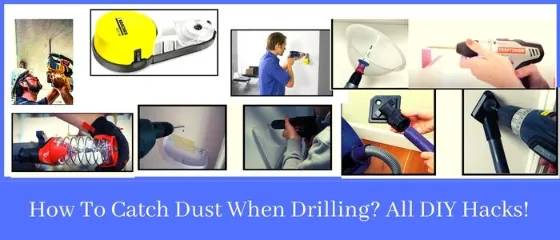Dust is an unwelcomed complement to any drilling job, whether you’re making holes on the walls or ceilings.
Not only does this result in a mess around the house but also, it’s hazardous for health, especially if you or someone in the family is allergenic.
Particles formed because of drilling masonry, concrete, or bricks can cause severe issues to your breathing ability.
It would be great if you could catch the remains during working, no more extra stress of cleaning afterward. But, how to catch dust when drilling?
There are multiple ways to do so. You can fix the problem with a drilling dust collector that requires a little investment or try a DIY approach.
In this discussion, I’ll share what I do to get rid of the floating dust and debris without spending a bank.
How To Drill Without Dust? Zero Investment Required!
Let’s start with saving your money. Following these dust cleaning ideas are great for those looking for a solution to household items. Check them out one by one.
1. Using Polythene to Catch Drill Dust
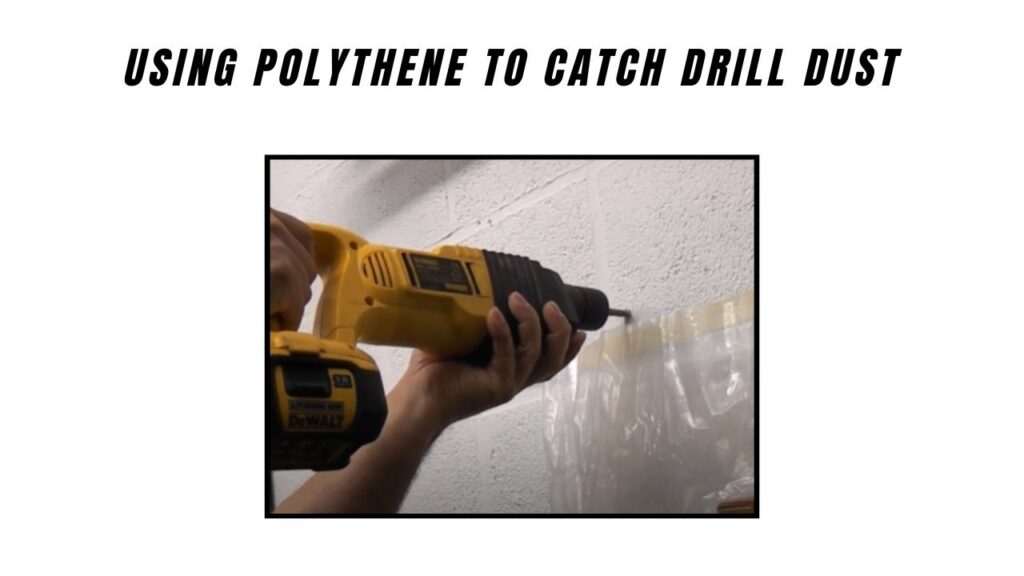
The easiest way to drill without dust is to add a polythene bag below the hole location you’ll drill.
Take a regular poly (2 lbs. ones are preferable). Then add scotch tape on one side of the opening. While attaching the tape, make sure half of the top tape line is open and the below half portion is pasted to the polybag.
Now set the open tape line under the hole point where you’ll drill. It’s like making a pocket for the wall under the drilling hole.
Some people may suggest you use a one-time DustBubble instead of a polybag. But I advise you not to waste your money on them. The design of this little plastic pack isn’t practical.
2. Add an Open Envelope or Paper Bag to the Wall
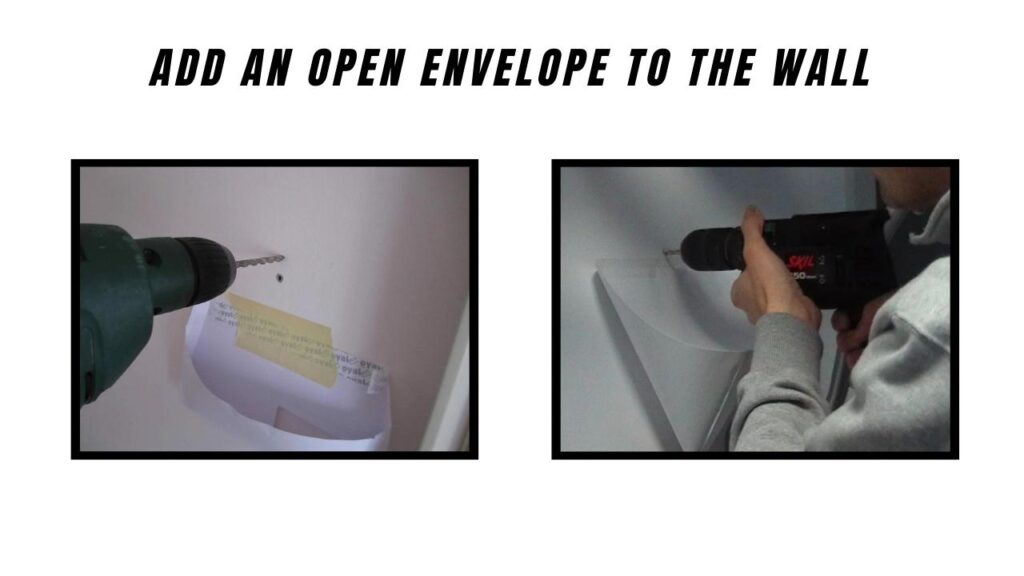
Another way to pocket the produced dust during drilling is using an envelope. To do that, you’ll need adhesive tape, paper gum, and an envelope/paper bag.
Simply stick a tape line on the envelope opener, keeping half to envelop and another half open.
While adding the tape, keep some extra line so that it can stick to the wall properly. Cling it to the wall.
Some fellow may advise to finish it here. But since the envelope opening isn’t big enough, you’ll still witness dust falling out of it.
To fix this issue, apply a little glue to both footer points of the envelope. Then attach the ends together, like giving it a funnel shape.
3. Use Post-It Notes
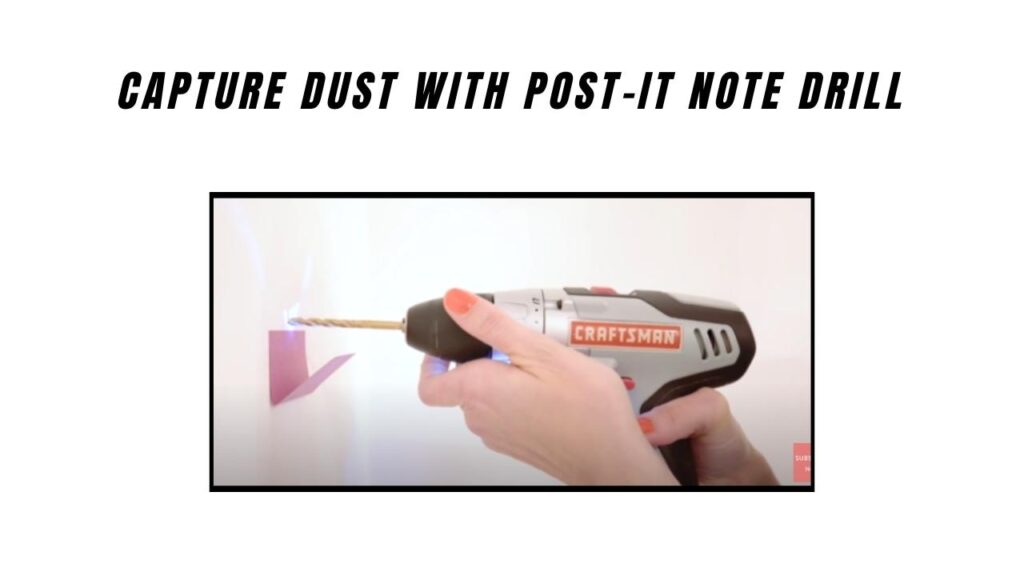
You can use regular sticky notes for trapping drill dust also. Just pick one note paper from the book. Then fold it into half.
Attach the upper folded part of the adhesive side to the wall. Apply a little strength with your palm on the paper to stick it firmly.
“Without the above methods, people also use a squirt bottle to collect dust while drilling. But this isn’t viable and causes much hassle to create a 3d nozzle.”
How to Catch Drill Dust with Different Attachments
The above methods don’t require any investment with little inefficiencies too. If you want to catch specks of dust with an airtight solution, the below methods are the best to follow.
1. Catch Dust with Universal Vacuum Cleaner
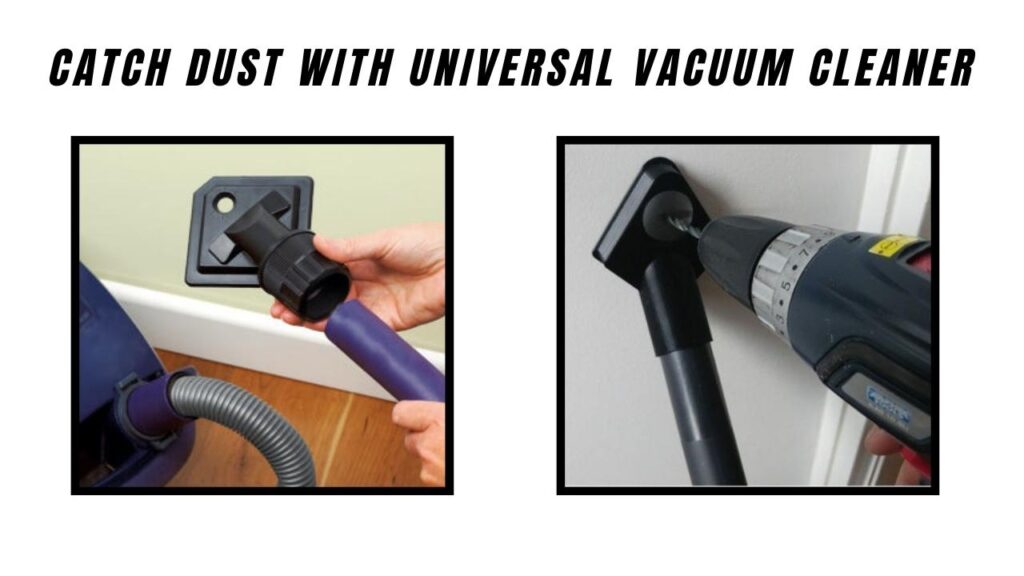
The above process is fairly efficient but leaves some dust particles around the workstation.
If you want to get a better dust cleaning solution, your existing vacuum cleaner can be a great help.
You’ll need a universal vacuum dust collector attached to your machine. They have a drill hole on the head where you’ll insert the bit. And the other end should be connected to your cleaning machine.
It’s quite an effective way to collect dust. With the support of the vacuum and the blocked surrounding of the collector device, dust can’t spread.
But there is a downside too. These universal vacuuming components are usually black and blocked-in design/shape, so getting a proper idea of the drill point is a bit tough.
You can also get a Universal Dust Shroud for Drilling.
2. Catching Drilling Dust with Battery Driven Vacuum
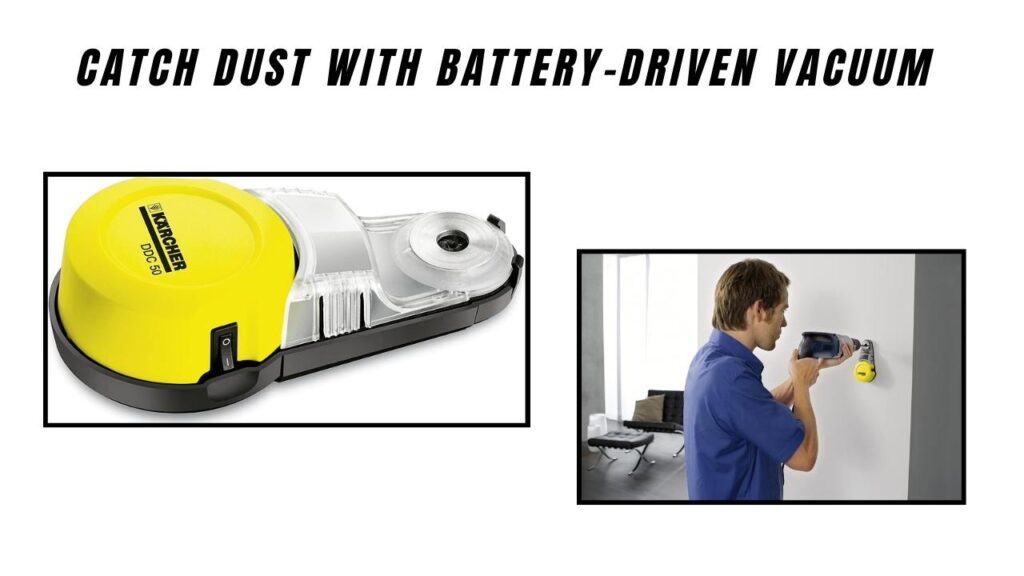
If you don’t have a vacuum cleaner, a battery-driven dust collector is another way to go.
Unlike the vacuum nozzle I mentioned earlier, it doesn’t require electricity, hose piping, or other support.
You just need to put it on the wall, aligning the hole point of the device with the actual wall hole where you’ll drill.
And when you drill, the little machine of the device will suck up and store all the residue generated during the process in its compartment.
If the dust compartment gets filled up, you just need to open the top locker and empty it. That’s it.
3. Use Drill Dust Trap
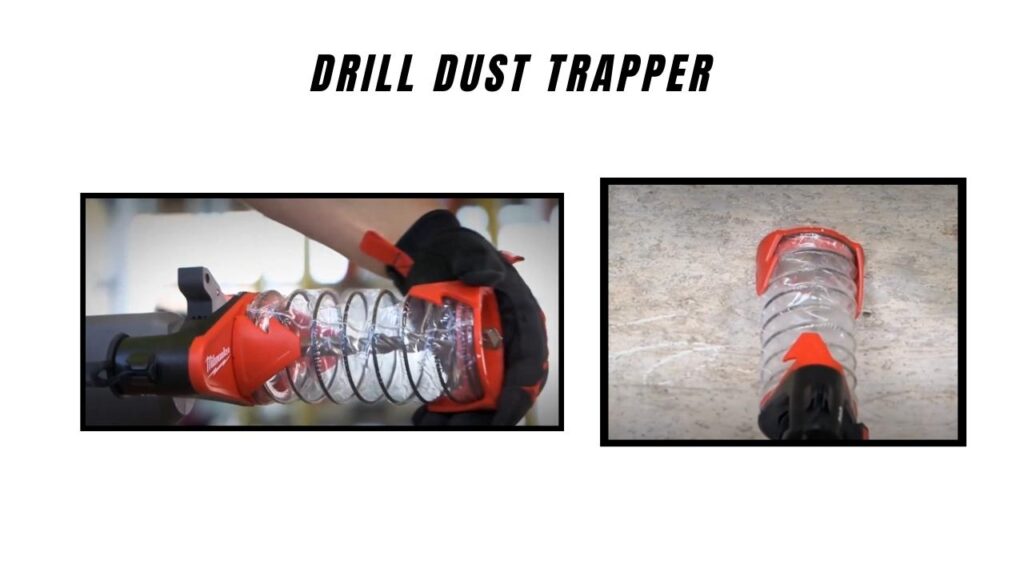
A drill dust trapper is also an effective solution if you don’t have a vacuum cleaner. It’s actually a spring covered with a plastic cover.
The gadget is built for both wall and overhead drillings. You just need to attach the bottom with your drill machine’s head; the rest is pretty straightforward.
When you drill with this add-on, it automatically shrinks the size following the hole depth. All generated dust particles will be stored inside the plastic cover.
After your job is done, simply throw away the residue trapped inside it.
I like this attachment because it fits perfectly with most SDS+ rotary hammers. The maximum drill bit size is 8-inch.
How To Catch Dust When Drilling Ceiling?
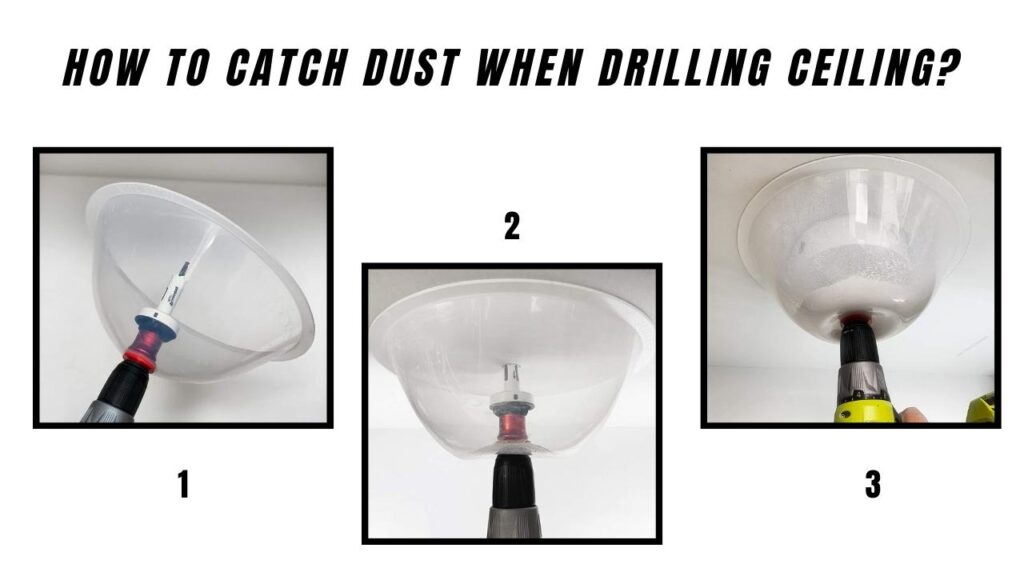
You can use any of the above when drilling walls. The problem occurs when drilling your ceilings.
As the gravitational force pushes the produced drill powder downward, they get into your eyes and all over your body. It’s both annoying and risky.
The best way to handle this situation is to use drill dust bowls. These are designed for universal drilling.
So, no matter what’s the bit’s size, they fit in perfectly. You can get one within a $20 budget.
Before I tried my first one, I thought this might struggle to survive heavy drilling and eventually snag.
But these silicone dust bowls are usually abrasion and heat resistant. Hence, they won’t be affected by the heat or scratches generated through drilling.
Using this tool is quite simple also. Put it on the ceiling drill point. Insert your drill bit through the hole of the bowl. Then position the drill bit along with the bowl where you want to drill.
And that’s it. When you drill, all the dust will be collected inside the bowl.
Universal Drill Dust Extractor – All in One Solution!
For both professional and DIY enthusiasts, this M12 Hammervac Univ Dust Ex Kit is a complete solution to handle the dirt out of drilling.
This cordless attachment has a slot to connect your drill machine. You can adjust the height of scale according to your drill bits also. And that’s all you need to do.
When you drill, the machine efficiently collects all dust inside the side compartment (one that covers the bit entry).
You can drill up to 8-inch in depth with this electric drill dust cleaner. The unique engineering allows you to trap dust whether you drill on the wall or ceiling.
“Drill extractor is mainly recommended for professionals because of its hefty nature (13.71 lbs.) Regular people won’t find it convenient for while working with a drill.”
Frequently Asked Questions About How To Catch Dust When Drilling
1. How do you drill concrete without dust?
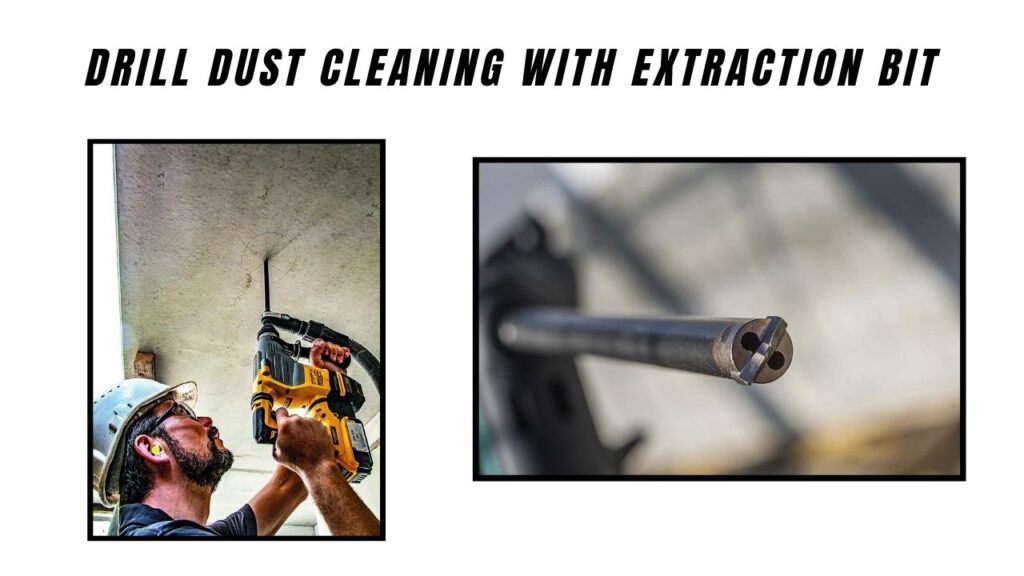
To drill concrete without dust, you need an extraction drill bit. This tool cleans out the borehole while drilling and saves a lot of your time when you put the epoxy afterward.
After marking boreholes with your bumper as a template, you should put the drill bit into the hammer drill. Then connect the vacuum cleaner and begin drilling.
There is no need for an extra cleaning hand as the extraction bit itself will suck up all the dust during the job.
2. Why is Concrete Dust Dangerous?
Concrete dust contains tiny particles of cement, sand, and other materials that can cause serious health concerns if inhaled.
In fact, according to the Centers for Disease Control and Prevention (CDC), exposure to concrete dust can lead to respiratory problems, including scars in the breathing vascular line, asthma, and even silicosis.
The dust may also cause skin irritation and allergic reactions.
3. Can a shop vac be used for dust collection?
Yes! You can use a shop vacuum cleaner as a dust collector if it has the proper filters and attachments.
4. How much CFM do I need for the dust collector?
The CFM of your dust collector depends on the size of the collector, the type of dust being collected, and the frequency of collection.
For a small, low-volume dust collector, an impeller with a rating of 1,000 CFM or less is usually sufficient.
Wrapping Up
That’s pretty much all about how to catch dust when drilling at home or workspace.
There are many ways to clean the dust created due to drilling walls, masonry, ceiling, or concrete. Among them, some may partially catch the particles using poly/paper bags and envelopes.
And some methods can give you complete safety. Comparing them all, the dust bowls and cordless dust collectors seem to perform great.
You can also use your household vacuum cleaner with a dedicated dust catcher attachment for the purpose.
Related Posts:
Can You Drill Holes In Apartment Walls?
